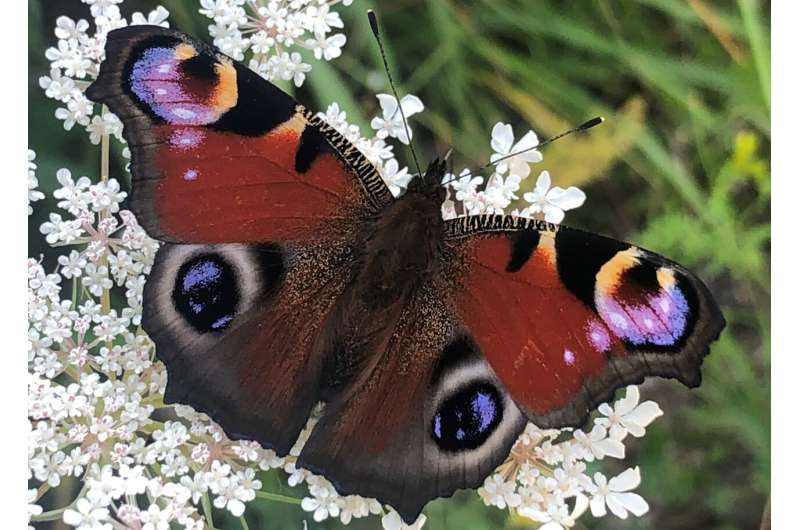The ultimate death stare: How moth wing patterns scare off predatory birds with amazing optical illusion

Many prey species have eyespot markings that are believed to ward off predators. But how, and does a predator's angle of approach make them less effective? Dr. Hannah Rowland and Dr. John Skelhorn write for Frontiers about their research, published today in Frontiers in Ecology and Evolution, into how these protective patterns on moth wings convince birds it's not worth attacking the insects.
How art mirrors life when it comes to moth wings
Have you ever felt that a person in a portrait is watching you, their eyes following you about a room? This optical illusion is known as the Mona Lisa effect, after Leonardo da Vinci's famously enigmatic painting. When artists paint their sitter's eyes with the pupils perfectly centered, no matter where visitors stand—to the left, right, or in front of the painting—eye contact is guaranteed.
Nature seems to have hit upon the same idea. But in the animal kingdom it can be a matter of life or death.
Eyespots
Many species of fish, butterflies, moths, praying mantids, and beetles have paired circular markings on their bodies that often appear to resemble eyes. Eyespots can deflect a predator's attention to a prey's non-vital body parts (a prey is much more likely to survive a bite to its tail than its head). Eyespots also can be intimidating and deter predators from attacking at all.
One explanation for this is that predators mistake eyespots for the eyes of their own predators. If this is the case, then eyespots that seem to look directly at them would be the most threatening. Much like the portraits whose eyes seem to follow you around the room, eyespots might appear to maintain eye contact with predators no matter their vantage point. On the other hand, if eyespots were displaced either to the left or right, they would only protect prey from predators approaching from that direction.
Another explanation is that eyespots have nothing to do with eyes. Predators could be deterred not because eyespots look like eyes, but simply because they are patterns that stand out. There are many conspicuous colors and patterns in the animal kingdom that are aversive to predators but look nothing like eyes—for example, the red and black patterns of ladybirds. Humans might perceive eyespots to look like eyes, but that doesn't necessarily mean that predators do too. They may simply see "scary" conspicuous markings.
Creating the ultimate death stare
We tested the idea that forward-facing eyespots appear to gaze at predators by pitting artificial moths against newly hatched domestic chicks. We created the moths by pinning paper triangles over mealworms—a favorite food of chicks.
The paper triangles were printed with eyespots in one of three configurations: either perfectly concentric circles, or with the center circle nudged to the right or left. All of the prey were designed to be equally conspicuous to the predators. To us, these appeared to gaze directly ahead or to one side. Would the direction of gaze affect the chicks' motivation to attack?
Staring death in the eye
Next, we built three miniature catwalks (well, actually, chickwalks) to lead the chicks towards the moth. One led directly towards the prey, and the two others directed the chicks to approach the moth from either the left or right. We timed how long it took a chick to approach and attack each type of moth from each of the three directions.
Chicks were slow to approach from the left when the moth's eyespots were shifted to the left, and slow to approach from the right when the moth's eyespots were shifted to the right. However, when chicks approached these moths from the opposite direction, they quickly approached the moth and ate the mealworm. The chicks were slow to approach the moths with concentric circle eyespots from all three directions.
Our results are consistent with the idea that the chicks perceived our artificial eyespots as eyes, and that eyespots are most effective when they appear to gaze at predators. Eyespots that are concentric circles appear to stare at predators from a wider range of directions, just like the portraits that maintain eye contact from wherever you stand. Which also probably explains why eyespots are so common in nature.
More information: John Skelhorn et al, Eyespot configuration and predator approach direction affect the antipredator efficacy of eyespots, Frontiers in Ecology and Evolution (2022). DOI: 10.3389/fevo.2022.951967
Journal information: Frontiers in Ecology and Evolution
Provided by Frontiers


















